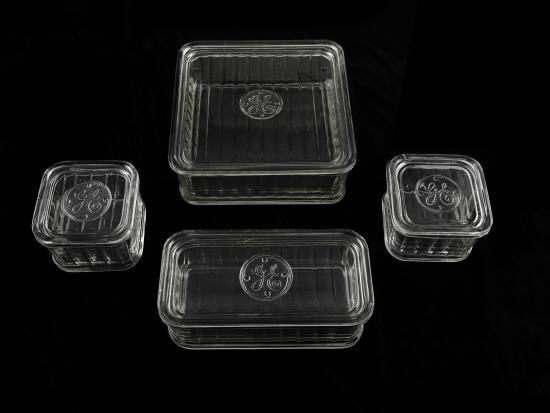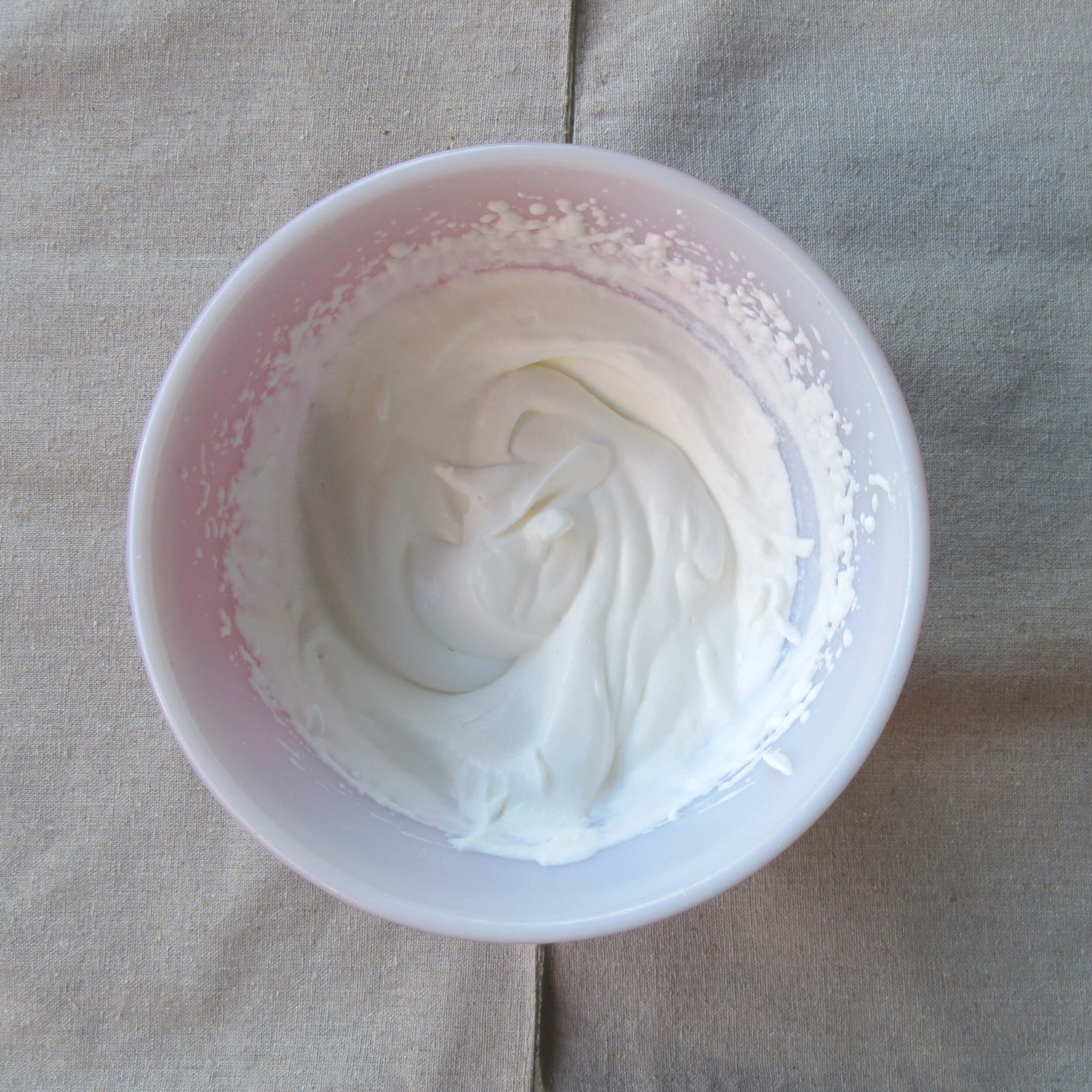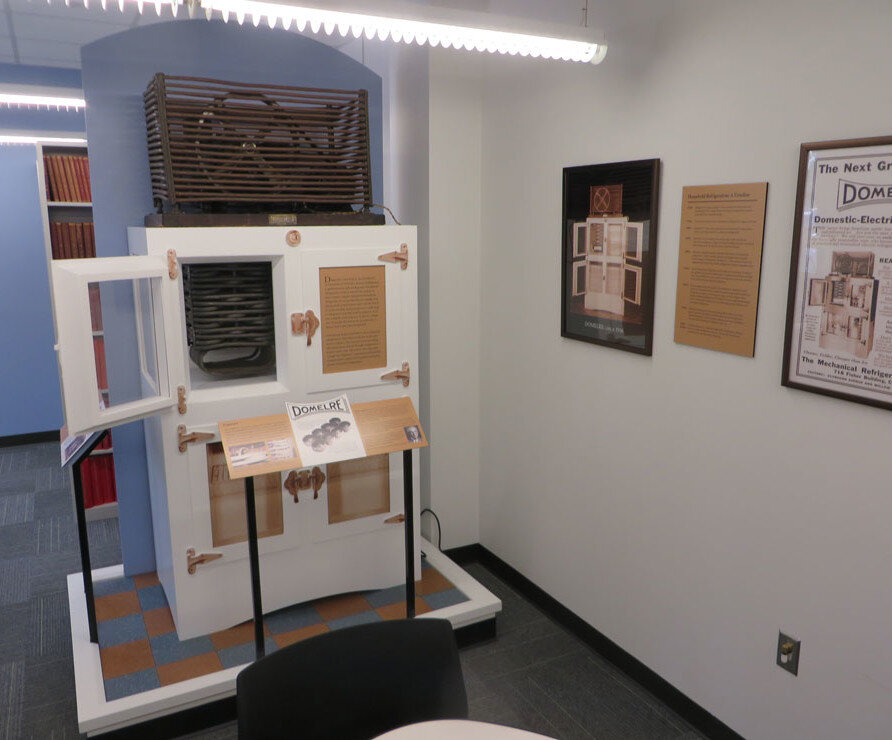Peppermint Whipped Cream
/You’ll find this recipe in:
Electric Refrigerator Recipes and Menus:
Recipes prepared especially for the General Electric Refrigerator
By: Miss Alice Bradley
Cleveland, 1927
Peppermint Whipped Cream is delicious served on top of Chocolate Mousse
Historic Recipe:
Chocolate Mousse – No. 40
Put in top of double boiler
¼ cup milk and
1 teaspoon gelatine. When milk is hot and gelatine is dissolved, add
½ cup cold milk, strain into refrigerator pan and put in freezing chamber of refrigerator. When cool beat until light. Meanwhile, melt over hot water
1 square chocolate, add
½ cup sugar
Few grains salt and
1 teaspoon vanilla and very slowly add
¼ cup milk. Stir until mixture boils. Strain and cool. Beat
½ pint cream until thick. Add beaten milk slowly and fold into chocolate mixture. Pour into refrigerator pan and freeze like Desserts and Salads That Need No Stirring, page 45. Serve if desired with
Whipped cream beaten stiff and flavored with vanilla or with oil of peppermint, or serve with Chocolate Sauce – No. 60.
My Peppermint Whipped Cream recipe:
1 cup 35% whipping cream – 237 mL
Start with 1 drop Peppermint essential oil or ½ tsp peppermint or vanilla extract and add more to taste
(I used 3 drops doTERRA Peppermint essential oil)
Beat the whipping cream until it is stiff and will remain peaked when you pull out the beaters. Customize your peppermint flavour (or vanilla flavour if that’s what you prefer) by adding your flavouring gradually to taste.
Peppermint Whipped Cream is very delicious served on Chocolate Mousse
***It’s important to stress that most essential oils on the market today are not safe to put in food because of the adulteration and contamination that are prevalent in this industry. For this reason, I’ll always suggest a food-safe substitute ingredient for the essential oil, like extract. Please look out for your safety and don’t use any old bottle of essential oil in the recipes on this blog! The brand that I use is doTERRA essential oils, which has extremely high standards for testing and purity, meaning that doTERRA essential oils can be safely used to flavour food.
Pop over here for more information about doTERRA & adulteration in the essential oil industry and if in doubt, use Peppermint extract in this recipe.
Along with Marshmallow Mint Sauce, Peppermint Whipped Cream is one of the suggested toppings for the Chocolate Mousse recipe from the 1927 cookbook Electric Refrigerator Recipes and Menus. With only two ingredients, Peppermint Whipped Cream is tasty and easy to make and is a delightful topping for the frozen mousse.
Written by Alice Bradley of the Boston Cooking School, Electric Refrigerator Recipes and Menus was a helpful resource for housewives who welcomed a General Electric Monitor Top Refrigerator into their kitchen. The Monitor Top was the first household electric refrigerator that was affordable for the middle class and it was advertised as a healthier, time-saving and money-saving option over ice refrigerators.
Early in the days of household refrigeration, companies supplied cookbooks to help women figure out how to effectively use their new appliance. Electric Refrigerator Recipes and Menus; Recipes prepared especially for the General Electric Refrigerator is part owner’s manual, part propaganda and part cookbook. Most of the book’s recipes focus on how to use the chilling unit (we’d call this compartment the freezer today), with chapters on Methods of Freezing; Ice Blocks – Plain and Fancy; Fruit Cocktails and Frozen Salads; Ices, Sherberts and Frozen Fruits; and Mousses, Parfaits and Ice Cream.
Early Days of Electric Refrigeration
The story goes back to 1748, when William Cullen demonstrated at the University of Glasgow that rapid heating of a liquid to a gas can result in cooling. The potential for developing technology with real-world applications from this idea ended up sitting on ice (hardy har) for almost a century.
In 1802, American Thomas Moore received a patent for the “refrigerator”, which was close to what we’d call an ice box. It was an oval wooden chamber with a hinged lid surrounding a tin box, with ice blocks in the space between the wood & tin and wool & rabbit fur insulation on the outside. Moore used his refrigerator to transport butter and the same year, he made an appointment to show his invention to Thomas Jefferson, who later purchased a refrigerator from Moore. Below, you’ll see Moore’s original letter to Jefferson, where Thomas Jefferson drew a sketch of the refrigerator in the margins. The use of ice boxes for household food storage didn’t become widespread until technological innovations in the ice harvesting industry happened in the 1820s and 1830s.
In 1835, a patent for “Apparatus and means for producing ice, and in cooling fluids” was granted to Jacob Perkins. It was the first functional vapour-compression refrigeration system, but it wasn’t a commercial success. Perkins built upon the designs of Oliver Evans, who was the first to conceive of the idea and propose a design for vapour-compression refrigeration in 1805, but never constructed a working example. From here, refrigeration gradually became perfected through inventors improving upon the patents of their predecessors and refrigeration transformed the commercial world in the last half of the nineteenth-century. Head over to my Rhubarb and Banana Fool recipe post to find out the part that refrigeration played in bringing bananas to the tables of the world.
Letter from Thomas Moore to Thomas Jefferson, with Jefferson’s sketch of the refrigerator in the margins, courtesy of the Library of Congress; potentially the only surviving DOMELRE refrigerator on display at the American Society of Heating, Refrigerating and Air-Conditioning Engineers; DOMLERE ice cube tray
Bringing Electric Refrigerators Home
The first refrigerator designed for household use was invented by Fred W. Wolf Jr. in 1913. The DOMELRE (DOMestic ELectric REfrigerator) didn’t feature a cabinet, but was a cooling unit that could convert the ice box you already own into a refrigerator. Besides bringing refrigeration into household kitchens, another innovation of the DOMELRE was that it was the first to include an ice cube tray. It wasn’t affordable for most people, since purchasing a DOMELRE was about $900, which was the average annual income at the time. In 1916, Wolf sold his rights to Packard Motor Car Company, which created refrigerators under the name of ISKO, which was purchased by Frigidaire in 1922.
Other early domestic refrigerators would include a cabinet made of wood similar to an ice box and the compressors were mainly driven by belt motors, some of which needed to be installed in the basement under the refrigerator. They were often loud and financially unattainable for most families. Purchasing a refrigerator could cost up to twice as much as buying a car.
Photograph of a Monitor Top Refrigerator from the collection at the Museum of Applied Arts & Sciences; advertisements courtesy of random people selling things on the internet
Enter the Monitor Top
Starting in 1927, General Electric unveiled the Monitor Top Refrigerator onto the domestic market, building upon technology from the GE 1910 refrigerator called the Dumbbell, which was mainly used by the dairy industry. The Monitor Top was constructed of stainless steel and featured a hermetically sealed cylindrical condenser on its top next to a temperature control. What really set the Monitor Top apart was the price. It hit the market with a price tag of $525, but was available after a few years for the ballpark of $200 to $225, with the option of an installment payment plan. When General Electric stopped making the Monitor Top in 1936, a family could purchase a Monitor Top Refrigerator for as little as $77.50.
This refrigerator got its name from the compressor’s distinct shape and it was named after a ship that had a similarly shaped gun turret. The USS Monitor was an ironclad battleship during the American Civil War that was built in 1861 and sank in 1862 during a storm. Have a look at these images to compare the refrigerator and its namesake ship.
The Victorious Union Gunboat “Monitor” (Naval History and Heritage Command); Monitor Top Refrigerator Advertisement; USS Monitor crew cooking on deck, July 9, 1862, by James F. Gibson (USS Monitor Center)
In Electric Refrigerator Recipes and Menus, Alice Bradley promotes the General Electric Monitor Top Refrigerator as essential to the family’s health, efficiency, frugality and even happiness: “The owning of such a refrigerator is a form of health and happiness insurance which every homemaker in American should have the privilege of enjoying.”
The Monitor Top was entirely made of stainless steel, so it was easy to keep clean on top of reducing instances of food poisoning. Fear of bacteria and a mother’s desire to keep her children healthy were definitely exploited to sell the Monitor Top Refrigerator. One advertisement states: “It’s always summer-time in your kitchen. And the dangers of food contamination are always present.”
Time was saved by eliminating the need for organizing ice deliveries, replenishing the ice and emptying the drip pan in ice boxes. “In using an ice-cooled chest very careful daily watch must be kept of the chest and all contents. This worry disappears with the General Electric Refrigerator.” Time was also purported to be saved because perishable food needed to be purchased less frequently and money was saved over time because “not only fresh food supplies but left-overs are kept from spoiling.”
It was also noted that a Monitor Top Refrigerator didn’t require frequent oiling or maintenance and didn’t create radio interference. “Since it is kept cold electrically, it need not be near an outside door, nor placed for the convenience of the ice man. All that is necessary is a convenience outlet into which its long cord can be plugged. The most convenient place in the pantry or kitchen is the place for the General Electric Refrigerator.”


Illustration from Electric Refrigerator Recipes and Menus showing refrigerator dishes, refrigerator pans and chiller tray; Chiller Tray; GE Covered Refrigerator Dishes courtesy of the collection at the National Museum of American History
The Monitor Top was also accompanied by accessories. Skip over to Chocolate Mousse to find out all about the Refrigerator Pans that were used when freezing recipes or ice. Each refrigerator would also come with a Chiller Tray (which has ‘CHILLER’ written on the side) that would slide underneath the chilling unit or freezer. The Chiller Tray would catch drips, but since that location under the chilling unit was the coldest area of the refrigerator, it was the perfect spot to stash ice cubes or other perishables that needed to be the coldest.
As well, a variety of Refrigerator Dishes with the General Electric logo on the lid were available. These dishes were safe to put in the oven as well as the fridge and were likely the precursor to kitchen dishes made later on by brands like Pyrex and Fire King.

















